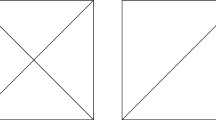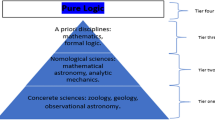Abstract
Philosophy of science in the twentieth century tends to emphasize either the logic of science (e.g., Popper and Hempel on explanation, confirmation, etc.) or its history/sociology (e.g., Kuhn on revolutions, holism, etc.). This dichotomy, however, is neither exhaustive nor exclusive. Questions regarding scientific understanding and mathematical explanation do not fit neatly inside either category, and addressing them has drawn from both logic and history. Additionally, interest in scientific and mathematical practice has led to work that falls between the two sides of the dichotomy. We might call these less narrow approaches ‘holistic’. Prior to 1918, work in the philosophy of science was also somewhat more holistic and interdisciplinary in nature. An exemplar of this type of approach is found in the work of Henri Poincaré. In this paper I will consider one particularly flexible tool Poincaré uses throughout his philosophical writings about science and mathematics: the tool of the unifying concept. More specifically, I will focus on one unifying concept: that of structure. I aim to show first, that structure is a unifying scientific concept for Poincaré; second, a focus on structure helps explain his scientific and mathematical success; lastly, this case study may provide a model for how unifying concepts can facilitate progress in mathematics and science.
Similar content being viewed by others
Notes
Title of Steinhoff (2021).
Recent interest in broader and interdisciplinary approaches, especially in practice-based work, is reminiscent of the older work. A difference is that much of the relevant philosophical work was formerly done by scientists, who were not so constrained by philosophical norms. There are also, of course, cultural-historical influences that could be considered (as an anonymous referee pointed out).
This is not to say Poincaré consciously or explicitly deployed this as a tool.
It is also not terminological.
Though I am not arguing for a psychological claim, I do think Poincaré was conscious of his emphasis on the idea of structure.
Thanks to an anonymous referee for pointing out the need for clarification here.
It is impossible to stipulate what kinds of connections are needed to turn a heap into a system, an instance of a structure, as this will surely depend on the objects and structures in question.
The ubiquity of structures prevents a precise explication of the general concept, and is not the main point of this paper.
For a famous argument that reference to natural numbers must be to a type (the number structure), see Benacerraf (1965).
For an architect or engineer, of course, the form precedes the physical instance. Nevertheless, the structure of a building would instantiate its form even after it is built; and we can distinguish the structure as building and the structure as type of building, by the process of abstraction.
In Wittgenstein this is used to point out that skeptical demands are generally unreasonable.
That is, he saw geometric axioms more as meaning-determinations than meaning-reflections. He rejects the view that that we know what ‘point’, ‘line’, and ‘plane’ mean apart from the axioms and uses; so acquaintance with geometric objects cannot determine the truths about them.
This seems especially clear in the case of geometry given his related views on conventionalism and implicit definition.
Thanks to Maria de Paz for helping me correct this point.
I am following the authorized translation for these references. As pointed out by an anonymous referee, the original French uses “monuments” twice rather than “structure” in this passage. As I indicated above, however, I am not interested in the term “structure”; my point is about the general idea. And—to me—terms like monuments, scaffolding, hierarchy, construction, relations, form, etc. all point to the family resemblance concept of structure, which is my focus.
Or at least types of relations and equations, since equations can be adjusted in light of new discoveries.
So, again, this paper can be seen as expanding on this view about scientific success, and arguing that it applies to Poincaré.
As Worrall (1989) famously argues.
Poincaré cites relations even for the nature of objects; but that doesn’t undermine their reality: “External objects […] are really objects and not fleeting and fugitive appearances, because they are not only groups of sensations, but groups cemented by a constant bond […] this bond is a relation.” (1905/1958, 137–138).
This is sometimes reflected in truisms, such as “[d]oubtless these relations, this harmony, could not be conceived outside of a mind which conceives them.” (Poincaré 1905/1958, 140)
Thus, Duhem as well as Le Roy appears to misinterpret Poincaré’s conventionalism; Duhem aligns conventions with mathematical definitions (1906/1954, 273) as “incapable of being refuted by experiment.” (1906/1954, 208) For Poincaré, conventions do play a quasi-definitional role for scientific testing and in the scientific hierarchy, but only a quasi-definitional role. They can thus be isolated from refutation, but in general they are neither rigid nor nominal: “if a principle ceases to be fecund, experiment, without contradicting it directly will nevertheless have condemned it”. (1905/1958, 110) Conventions, even in geometry, are therefore flexible and responsive to empirical data. “We choose the geometry of Euclid because it is the simplest. If our experiences should be considerably different, the geometry of Euclid would no longer suffice to represent them conveniently, and we should choose a different geometry.” (1898, Conclusions, 1011) For a more detailed argument for this view of conventionalism see Folina (2014), as well as other papers in the volume. Thanks to Maria de Paz for the question.
And indeed evolution, which is necessary for producing beings capable of knowledge.
Like the role of “red” in color language as well as our agreement about ‘objects’.
For a careful analysis of ‘crude facts’ and their relation to ‘scientific facts’ see de Paz (2018).
A benefit is that his version of structural realism comes with a nice Darwinian twist: we can discover significant features of reality because our sensory and cognitive mechanisms evolved to fit those features.
I have thus come to disagree with some aspects of Brading and Crull (2017), who argue that his structural realism is strictly epistemic.
Sometimes called ‘methodological’ structuralism. See for example, Reck and Price (2000).
This connects to his view that human minds are ‘built’ by evolution to perceive scientific and mathematical structures, and to find them aesthetically pleasing.
Though, as we shall see, in a more ‘operational’ than a domain-oriented sense like the first two. Heinzmann (1998) also notes these three key structures for Poincaré, calling the second and third, “topological intuition” and “algebraic intuition”.
For a more detailed explanation, see Folina (2020).
Plausibly, it underpins our understanding of empirical induction as well.
Though iteration is invoked here to generate numbers, as for Kant, time is what forms the intuitive basis of mathematics for Brouwer.
For a more detailed argument for this particular point, see Folina (2006).
Including the domain of ‘well-formed-formulas’ of a symbolic logic system.
At least generally, in that most mathematical areas presuppose iteration, in the form of recursive definition and mathematical induction, while some also deploy the group concept and/or the continuum.
Along with more attention to scientific practice, there is interesting recent work on the relationship between physics and mathematics; for example see the articles in Russ (2011). For the symbiosis between mathematics and physics, which I only mention here, but which Poincaré emphasizes, see also Jaffe and Quinn (1993) as a starting point.
For recent historical work on the importance of the concept of structure in mathematics, see papers in Reck and Scheimer (2020).
References
Benacerraf, P. (1965). What numbers could not be. Phil Review; reprinted in Benacerraf and Putnam (1983), 272–294.
Benacerraf, P., & Putnam, H. (1983). Philosophy of mathematics. Cambridge University Press.
Brading, K., & Crull, E. (2017). Epistemic structural realism and Poincaré’s philosophy of science. HOPOS, the Journal of the International Society for the History of Philosophy of Science 7: 108–129.
Brouwer, L.E.J. (1913). Intuitionism and formalism. Bull. AMS; reprinted in Benacerraf and Putnam, (1983), 77–89.
Brouwer, L.E.J. (1952). Historical background, principles, and methods of intuitionism. South African Journal of Science 49; reprinted in Ewald (1996), 1198–1207.
de Paz, M. (2014). The third way epistemology: a re-characterization of Poincaré’s conventionalism. In Poincaré, philosopher of science, eds. M. de Paz & R. DiSalle, 47–65.
de Paz, M. (2018). Poincaré on generalizations and facts: construction or translation? Foundations of Science 23: 549–558.
de Paz, M., & DiSalle, R. (2014). Poincaré, philosopher of science. Springer.
Duhem, P. (1906). The aim and structure of physical theory. Princeton University Press.
Ewald, W. (1996). From Kant to Hilbert, a source book in the foundations of mathematics. Oxford University Press.
Folina, J. (2006). Poincaré’s circularity arguments for mathematical intuition. In The Kantian legacy in nineteenth century science, eds. M. Friedman & A. Nordmann, 275–293. MIT press.
Folina, J. (2014). Poincaré and the invention of convention. In Poincaré, philosopher of science, eds. M. de Paz & R. DiSalle, 24–45. Springer.
Folina, J. (2019). Science, hypothesis and hierarchy, essay review (of new translation of Science and Hypothesis and some relevant secondary literature). HOPOS, the Journal of the International Society for the History of Philosophy of Science 9: 388–406.
Folina, J. (2020). Poincaré and the pre-history of structuralism. In The pre-history of mathematical structuralism, eds. E. Reck & G. Scheimer, 273–302. Oxford University Press.
Heinzmann, G. (1998). Poincaré on understanding mathematics. Philosophia Scientiae 3: 43–60.
Jaffe, A., & Quinn, F. (1993). Theoretical mathematics: Toward a cultural synthesis of mathematics and theoretical physics. Bulletin of the American Mathematical Society 29: 1–13.
Poincaré, H. (1898). On the foundations of geometry. The Monist IX:1–43; reprinted in Ewald (1996), 982–1011.
Poincaré, H. (1902). Science and hypothesis, references to authorized translation (Halsted) in Poincaré 1982.
Poincaré, H. (1905). The value of science, references to authorized translation (Halsted), Dover (1958).
Poincaré, H. (1906). Mathematics and logic: II, references to Ewald translation in Ewald (1996), 1038–1052.
Poincaré, H. (1908). Science and method, references to authorized translation in Poincaré (1982).
Poincaré, H. (1913). Mathematics and science: Last essays. John Bolduc transl. Dover (1963).
Poincaré, H. (1982). The foundations of science. Halsted, transl. University Press of America (first published in 1913).
Reck, E., & Price, M. (2000). Structures and structuralism in contemporary philosophy of mathematics. Synthese 125: 341–383.
Reck, E., & Scheimer, G. (2020). The pre-history of mathematical structuralism. Oxford University Press.
Russ, S. (2011). Guest editor, Interdisciplinary Science Reviews (special issue on Unreasonable Effectiveness of Mathematics) 36(3).
Steinhoff, A. (2021). Europe’s long nineteenth century: An age of transitions, 1789–1918. Bloomsbury Academic.
Wittgenstein, L. (1972). On certainty. Edited by Anscombe, von Wright. Harper & Row.
Worrall, J. (1989). Structural realism: The best of both worlds? Dialectica 43(1/2): 99–124.
Funding
No funding to declare.
Author information
Authors and Affiliations
Corresponding author
Ethics declarations
Conflict of interest
All the authors declare that they have no conflict of interest.
Ethical approval
This article does not contain any studies with human participants or animals performed by any of the authors.
Additional information
Publisher's Note
Springer Nature remains neutral with regard to jurisdictional claims in published maps and institutional affiliations.
Rights and permissions
Springer Nature or its licensor holds exclusive rights to this article under a publishing agreement with the author(s) or other rightsholder(s); author self-archiving of the accepted manuscript version of this article is solely governed by the terms of such publishing agreement and applicable law.




